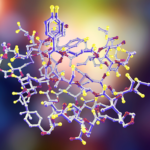Does polycystic ovary syndrome affect fertility?
The function of two ovaries present in the female pelvis is to produce hormones and an ovum every month in sync with the menstrual cycle. The aim of this activity in adult females is fertility. Now let us see, what happens when multiple cysts (a cyst is a cavity lined with epithelium and contains fluid) are present in both ovaries in the disorder called ‘Polycystic Ovary Syndrome.
Polycystic Ovarian Syndrome
PCOS is an endocrine disorder in women due to androgen (male sex hormone) excess which is produced by the ovary. It is characterized by ovulatory dysfunction, mild hirsutism (male pattern growth of hair), acne, or rarely excessive masculinization. It is the most common cause of androgen excess in females and results in chronic anovulation and infertility. The ovaries of the majority of these patients (up to 90%) contain multiple 2-8 mm sized follicles on their surface. This is what gives the ovaries a polycystic appearance as seen during ultrasonography.
Hormonal changes in PCOS
- Testosterone levels are elevated in 70% to 80% of women with PCOS.
- DHEAS (dehydroepiandrosterone sulfate), an adrenal androgen metabolite is elevated in 25% to 50% cases.
- LH/FSH ratio is 2:1 or 3:1 in approximately 60% of these patients.
- Hyperinsulinemia (increased insulin levels) due to insulin resistance.
Other features of PCOS
Clinically evident PCOS tends to develop shortly after menarche (onset of menstruation during puberty) and persists through the reproductive life of the patient. Resistance to the action of insulin develops in these patients which may stimulate increased androgen production. They also have glucose intolerance or type 2 Diabetes. More than half of the patients also have associated obesity (BMI >30 kg/m2).
Long term PCOS may result in the following conditions:
- Infertility – this is the most common reason with which these patients are present in the outpatient clinic. The majority of menstrual cycles of these patients are anovulatory. Ovulation is unpredictable and difficult to treat with ovulation-inducing agents like clomiphene citrate. If pregnancy occurs, they have an increased risk of abortion.
- Dysfunctional uterine bleeding
- Increased risk of malignancy of the endometrium (lining of the uterus).
- Diabetes – it progresses from glucose intolerance to type 2 diabetes. During pregnancy, these patients are prone to develop gestational diabetes. This is aggravated by the high occurrence of obesity in these patients.
- Cardiovascular disease like hypertension occurs in many patients and is associated with obesity. The hyperinsulinemic state is associated with a deranged lipid profile, which may manifest as stroke due to atherosclerosis.
Treatment
The treatment of PCOS follows these four broad guidelines.
1. Treatment of anovulatory infertility:
- Weight loss in obese patients may be the first step in achieving regular menses. Weight loss in obese patients results in lowering of blood androgen levels and resumption of menses. Laparoscopic bariatric surgery (obesity surgery) may have a role in this case.
- Ovulation induction for the treatment of infertility due to androgen excess includes the use of clomiphene citrate and human gonadotropins. Eighty-five percent of women with PCOS will ovulate after taking clomiphene citrate.
- Surgery: Laparoscopic cautery and laser treatment of the ovaries have been used in an attempt to induce spontaneous ovulation. It is based on the assumption that a reduction in the androgen-producing ovarian cortex by surgical destruction will allow ovulation to occur.
2. Regulation of uterine bleeding – this is done to achieve regular monthly menses. It reduces the risk of endometrial hyperplasia, endometrial cancer, DUB, and secondary iron deficiency anemia. This can be achieved with oral contraceptive pills and progestogens. Oral contraceptive drugs act by suppressing the circulating LH and FSH, leading to a decrease in ovarian androgen production. In patients with excessive uterine bleeding, who have completed their family; hysterectomy (removal of uterus by surgery) may be performed. Weight loss as discussed above is also useful.
3. Treatment of diabetes and prevention of cardiovascular risk factors. The use of insulin-sensitizing agents like metformin has a role for both.
4. Treatment of dermatological abnormalities such as hirsutism, acne, or alopecia (hair loss). It works out with anti-androgen treatment and also requires the services of a dermatologist.




























